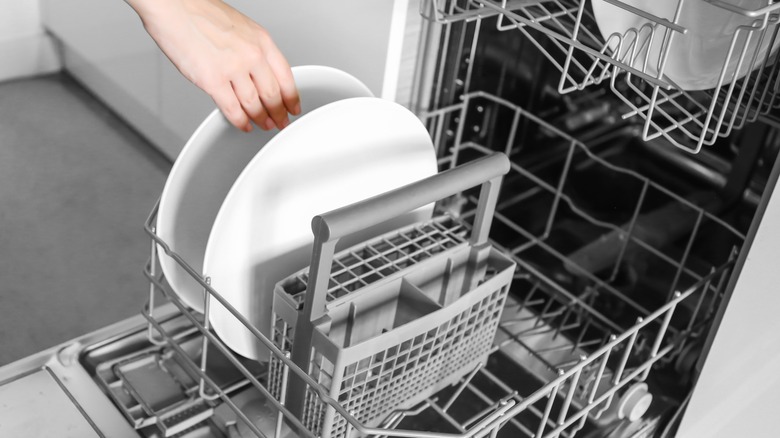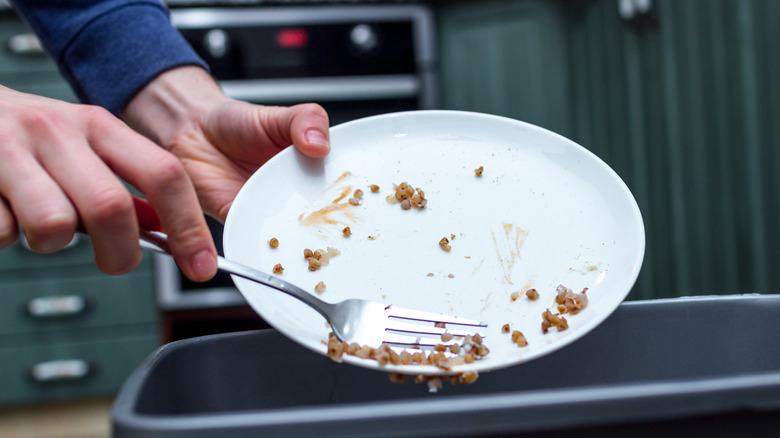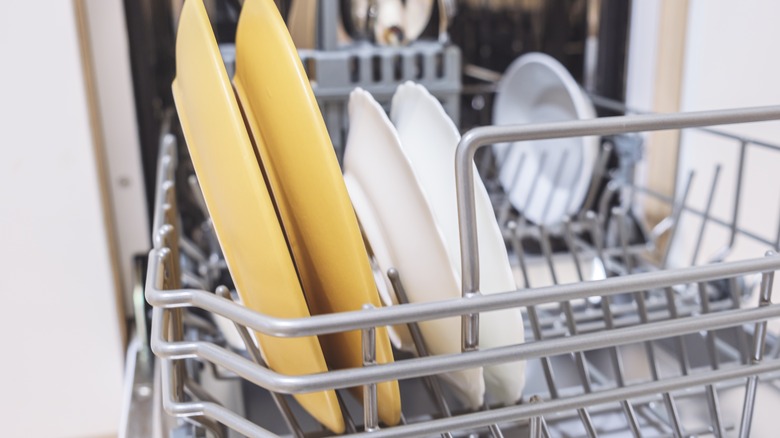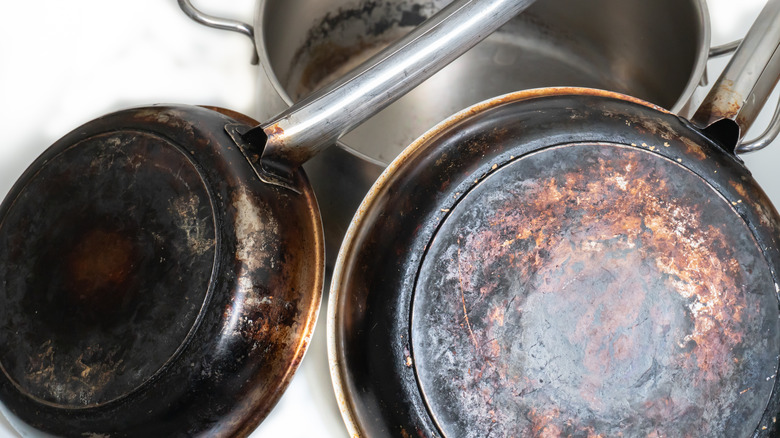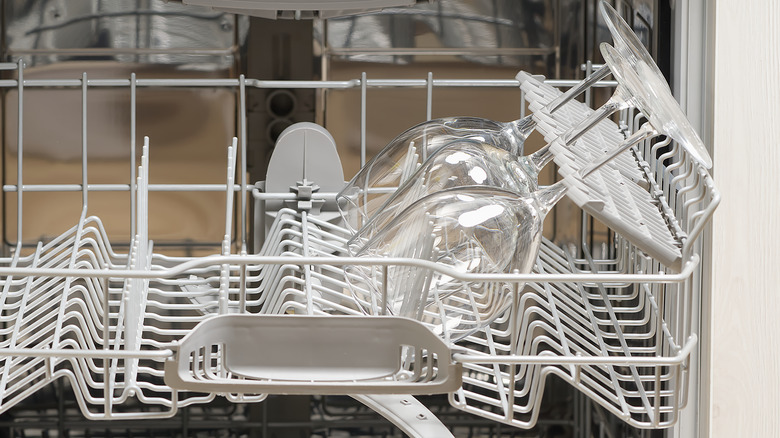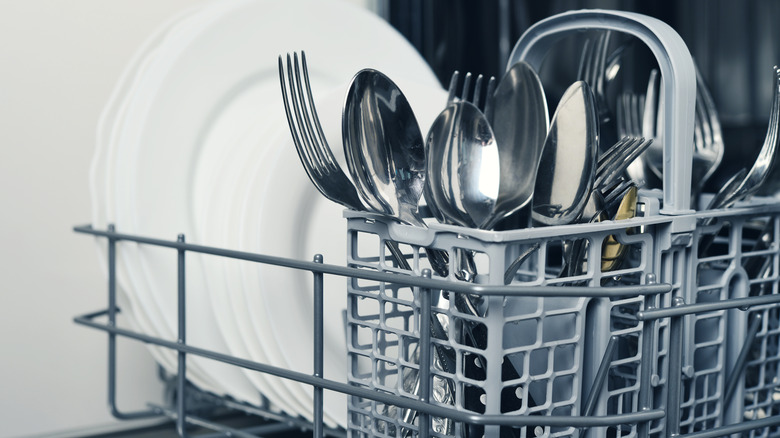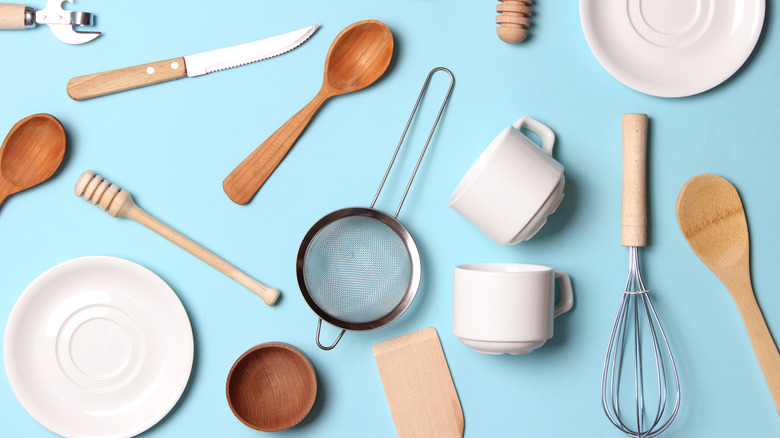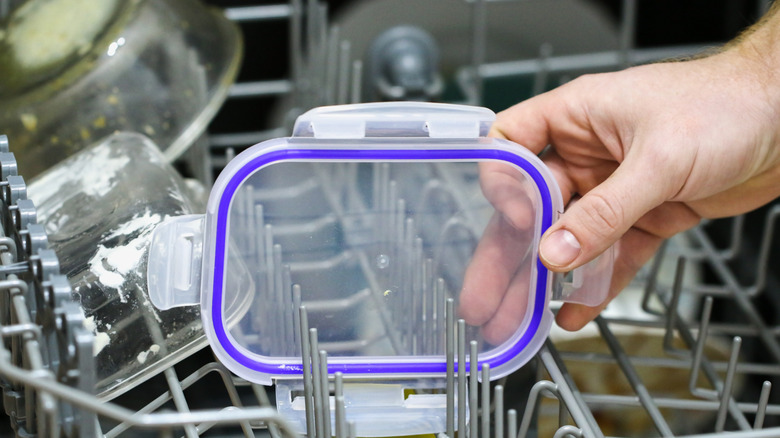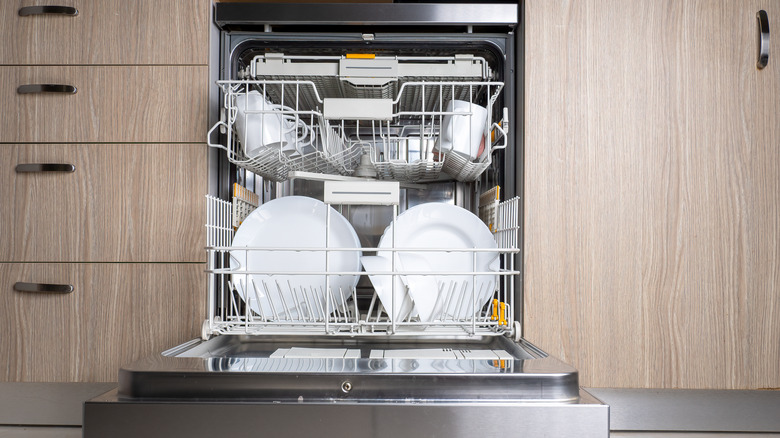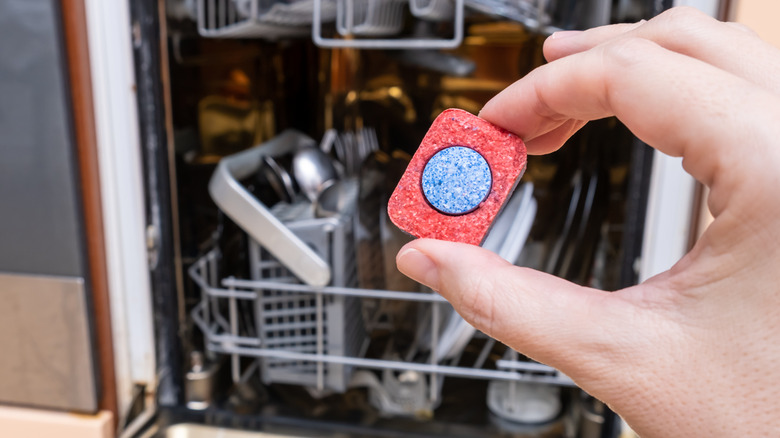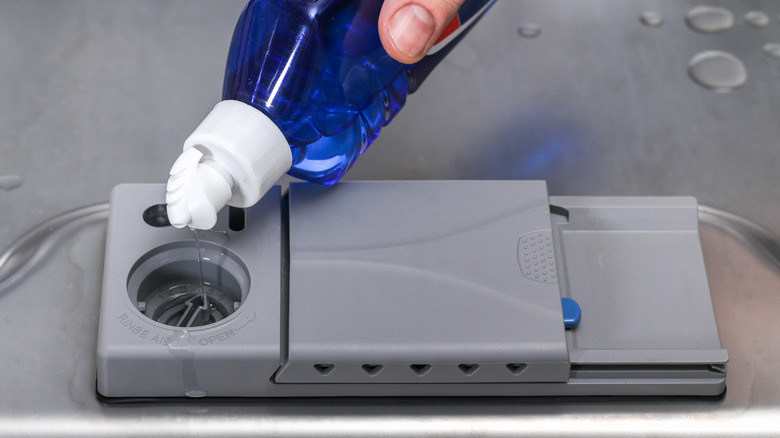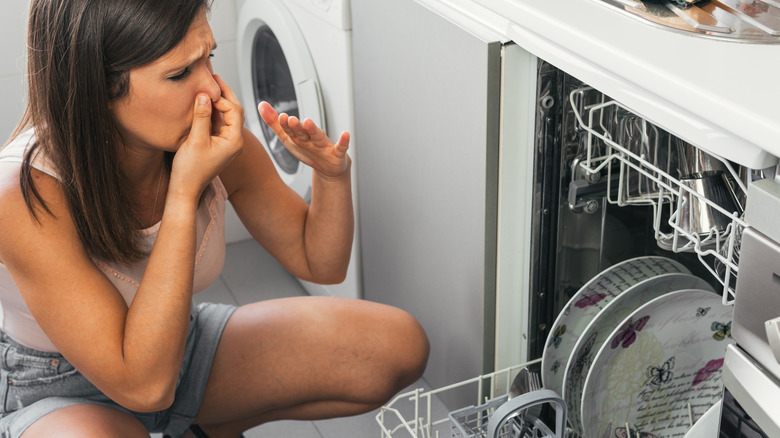The Ultimate Guide For Loading Your Dishwasher The Right Way
Dishwashers have been an essential appliance in American homes for more than a century, ever since the very first dishwasher was patented in 1886 by Ohio's Josephine Cochrane. Cochrane was the wife of a wealthy businessman. She loved entertaining and was known for her lavish dinner parties. But as much as she loved hosting parties, she also hated having her dishes washed by hand, especially when her servants were prone to accidentally chipping her fine china. She was convinced there had to be a better way to get the job done, so she created the first-ever mechanical dishwasher with water jets and a dish rack, and the rest is "her-story."
As dishwashers advanced from Cochrane's very first machine, they didn't just become giant time savers. They also soon proved more efficient than hand washing could ever be, doing the job more effectively with less time and using less water, and sanitizing at temperatures that human hands can't tolerate. Today, close to 90 million American homes sport one of these incredible machines. The dishwashers may be everywhere, and we all love using them, especially when the alternative is washing dishes by hand. However, very few of us have ever taken the time to study up on the best ways to use our dishwashers, and that's why so many people continue to load their dishes incorrectly, cramming pots where they don't belong, on an almost daily basis. If you're one of them, you might need some dishwasher tipis!
1. Scrape all the large food particles from your dishes
It doesn't matter which make or model of dishwasher you have. They all function in pretty much the same way. And they all require the same types of prep and loading if you want your dishes to come out clean. One of the most important things you can do when loading any dishwasher is to make sure you scrape all the big chunks and pieces of your dinner off your plates and out of your pots and pans before you load them into your machine. And if the food is really stuck on, soak your dishes in the sink to loosen that debris before you try to wash them!
Repeat after us: The dishwasher is not a garbage disposal. Large food particles will clog the dishwasher's drainage system. When this happens, the water in the dishwasher can back up, and it may even overflow onto your floor, potentially causing expensive repairs for you or for anybody living beneath you. Equally as disturbing: A dishwasher filled with large chunks of food or big unwanted food particles isn't going to properly clean your dishes. Think about it: How clean can any dishes end up if there are chunks of carrots and peas and bits of chicken floating around in the water being used to clean them? Even worse, that leftover food is just going to get baked onto your dishes when the dishwasher goes into drying mode. Blech!
2. Load plates and bowls in the bottom rack
Plates are one of the most commonly washed items in most dishwashers, and where you place your plates in the dishwasher is essential for making sure they come out as clean as possible. So where should your plates go? In the bottom rack, facing towards the center. The bottom rack of the dishwasher is designed specially so that water sprays up and hits the bottom of your dishes. Putting your plates and bowls in the bottom rack ensures that they get maximum exposure to that steamy, soapy spray and that any stuck-on food is blasted free by the machine's powerful jets.
The bottom of the dishwasher is also typically larger and deeper, which allows more room for large plates than the upper rack. The one exception to the rule? If you are washing a large number of plates, science shows it's actually better to arrange them in a circular pattern (all facing the center of the machine) than lining them all up, slot by slot, facing the same direction across the width of the machine.
In a study on dishwasher science conducted at the University of Birmingham, researchers found that this circular pattern, with a large number of plates, actually allowed more water to hit the plates and clean their surface than when they were all facing the same direction.
3. Place larger items in the rear of the machine
When it comes to placing pots and pans in a dishwasher, you want to maximize space since these items tend to be so large and bulky. The rear of the dishwasher, with its wider, deeper dimensions, is the ideal spot for plates to go. Putting pots and pans in the lower rear portion of the machine not only prevents them from blocking the flow of water to smaller items but it also ensures better overall coverage and exposure to the water spray and detergent, ensuring that they come out clean.
Another advantage? If all the pots and pans are in the back of your machine, they're less likely to bump against and damage smaller, more delicate items like plates, saucers, and glasses. Plus, pots and pans placed on the bottom rack of the dishwasher are also generally closer to the machine's heating element, so they'll also dry faster and more efficiently than if they were placed higher up in the machine. Just be careful not to pack your pots and pans too tightly into the back of your machine. You still want to leave enough space between them and between other items in your dishwasher so that water and detergent can reach every surface and everything comes out nice and clean.
4. Load glasses and cups in the top rack
It doesn't matter if you're washing juice glasses, water glasses, cocktail tumblers, or crystal stemware, the proper place for all the glasses to go in virtually every dishwasher is upside down in the top rack. Why? First off, most of the water in the dishwasher sprays upwards from the bottom of the machine. so placing your glasses upside down ensures maximum washing. This upside-down positioning is also useful for preventing water spots and making sure the glasses drain properly after being washed: The water literally drips off them as they dry, leaving them shiny and crystal clear.
With all of your larger plates and pots and pans in the lower rack, placing your more delicate glasses in the upper rack also helps to keep these fragile and delicate items securely in place and reduces their chances of being bumped or damaged as they are being washed. Since they are typically a similar size and also often made from glass (and are therefore fragile), coffee cups and mugs, and small bowls should also go in the top rack of your dishwasher, in the remaining space next to your glasses. Secure all your items in place with the dishwasher rack prongs so nothing tips over. And don't allow any of your dishes to touch one another, so there's plenty of room for all that hot water and detergent to do its thing, leaving all your glassware sparkling.
5. Put silverware in the utensil holder
Like the great debate on whether toilet paper rolls go over or under the spool, everybody seems to have an opinion on how dishwashers should be loaded. In fact, studies show that a staggering 65 percent of men and women in the country believe there is a "right way" and a "wrong way" to load the dishwasher. The biggest topic of debate? Does the silverware go in with the handle facing up or facing down? The answer? If you are concerned about making sure your silverware is as clean as possible, wash it with the handles facing down! This allows for a maximum flow of water and detergent to reach the fork or spoon on the end of the utensil, ensuring that they are thoroughly cleaned and that there is no leftover food stuck to them.
Silverware that is washed with the handles facing down is also less likely to shift around during the wash cycle, preventing scratching or damage to the utensils. In contrast, silverware washed handle up gets less water exposure and is also more likely to nest together in similar positions, and may not get cleaned at all. The one exception to all of this is small knives. For safety's sake, if you are washing a knife with your silverware, it should generally go blade down so you don't accidentally cut yourself while putting in the machine or taking it out after washing: Debate over!
6. Load cooking utensils in the top rack
While forks and spoons have a handy holder to keep them in place when you put them in the dishwasher, ladles, spatulas, and other large cooking utensils are not so fortunate. Because of this, the best place you can generally put them in your dishwasher is crosswise in the top rack. The biggest reason to keep large cooking utensils towards the top of the dishwasher is safety. You don't want them to slip through the rack and interfere with the spray arm located at the bottom of the dishwasher. Since the spray arm rotates during the wash cycle, distributing water and detergent to all areas of the dishwasher, anything that obstructs its movement will not only keep your dishes from coming clean: It could cause damage to the machine itself.
Placing large cooking utensils in the top rack of the dishwasher also ensures a more thorough cleaning overall since the top rack is designed to hold smaller items and also tends to have a more powerful, concentrated spray of water. Also, keep in mind that some types of cooking utensils, including wooden spoons, cast iron cookware, meat thermometers, plastic utensils, and silver or silver-plated knives or serving spoons, shouldn't go in the dishwasher at all. The high heat of the dishwasher can damage or, in some cases, even ruin these types of utensils, so they are always better off being washed by hand.
7. Keep all Tupperware in the top rack
Ever walk into your kitchen only to be overwhelmed by the harsh, acrid, chemical scent of burning plastic? Then chances are, you've discovered that it's never a good idea to wash plastic plates or spoons or plastic food storage tubs and bins like Tupperware in the dishwasher. There are a number of reasons why this is a bad idea. For starters, all of these items are prone to melting and warping when exposed to high heat, like the heat the heating element in your dishwasher gives off in an attempt to dry your dishes. In some cases, this heat alone can be enough to cause the plastic to buckle or melt.
And if any of your plastic dishes were ever to get too close to this heating element in action, your plastic is a goner: It's going to melt, ruining the dish, filling your kitchen with toxic gasses, and possibly even melting onto the dishwasher heating element in a way that can damage the dishwasher itself. There's also a risk to your own health if you eat or drink from plastic that has been exposed to high heat. This exposure can cause the plastic to release harmful chemicals, such as bisphenol-A (BPA) and phthalates, that can then find their way into your food or beverages. And studies show a number of potential health risks associated with this exposure, including an increased risk of cancer, hormonal imbalances, and possibly infertility.
8. Don't overcrowd the machine
Got all your dishes loaded into the dishwasher and ready to turn it on? Good! Now take one last look at the way you have it filled and ask yourself: Am I trying to cram too much in here? The reality is that while you might be able to jam-pack a lot of dishes into your dishwasher, you probably don't want to, especially if you want your dishes to come out as clean as possible. One of the biggest errors most people tend to make when loading a dishwasher, after simple placement of their dishes, is loading the dishwasher too densely and overcrowding their dishes.
In order for your plates and glasses and pot and pans to come clean, a steady and consistent flow of water has to be able to access every part of their surface. And if your dishwasher is overcrowded, those powerful cleaning jets of detergent-laced hot water aren't going to hit your dishes evenly, and you're going to end up with a load of dishes that are partially clean and partially still dirty. Dishes that are crowded together are also more prone to chipping and breaking, especially if they are knocked around repeatedly during the wash cycle. Additionally, they may not dry properly, which can lead to water spots and streaks.
9. Use a quality detergent
Once you've got your dishwasher loaded, the last and perhaps most essential step is using a quality dishwashing detergent to make sure your dishes are clean enough to eat off of! Just remember that not all detergents are created equal. Powder detergents tend to be the most affordable option for getting dishes clean, but they can be messy in hard water in particular and may not always dissolve completely, leaving a chalky, gritty residue on your dishes. Gel detergents are easier to use but can sometimes leave a sticky coating on dishes when the water in your dishwasher isn't hot enough.
For those reasons, tablets generally tend to be the best option. They dissolve well, are eco-friendly, and often include built-in additions like rinse aids or glass protectors. Unfortunately, that convenience comes with a price, as dishwasher tablets also tend to be the most expensive detergent option. When possible, opt for dishwasher detergents with phosphate-free formulas. And if you ever run out of detergent and are in a pinch, remember that dish soap should never be used in a dishwasher in place of dishwashing detergent. Dish soap creates significantly more suds when combined with water than detergent does, and all that soapy foam can leak out of your machine onto your kitchen floor. In some cases, it can also damage the motor or other internal components of the dishwasher itself. Better to wash by hand in that case than risk a problem!
10. Don't forget the rinse aid
Risne-aids are more than just a marketing gimmick: They play an essential role in the dish-cleaning process. These products contain a mixture of ingredients that literally alter the surface tension of water, breaking up water molecules and making the water flow off dishes more easily. This improved flow of water helps in the cleaning process, but its biggest benefit occurs when the dishwasher switches from the wash function and starts drying your plates and glasses. Because the water runs more easily off your dishes, they dry quicker and more efficiently and are far less likely to develop water spots or streaks. So your glasses are not only cleaner in the end, they look cleaner too!
Most dishwashers contain a built-in rinse aid dispenser. Look for either a small reservoir or a small compartment on the interior of the door of your machine. If your machine doesn't have one, go online and order a rinse aid basket which can be added to the top rack of your dishwasher. One last word of caution: Some social media kitchen "hackers" suggest using household items such as vinegar or lemon juice as a substitute for rinse aid. Bad idea! These products don't break up water in the same way during the wash cycle, and they can even damage your dishwasher over time. In this case, it's better to use a rinse aid built for the job than to go DIY.
11. Make sure you clean your dishwasher regularly!
Even the best dishwasher needs some TLC on a regular basis to keep it operating at its peak and to ensure it cleans your dishes as effectively as possible. Whether you use your dishwasher once a week or every single night, over time, food particles, soap scum, and other debris can build up inside the machine. This can lead to weird smells in your kitchen, poor cleaning performance, bacteria growth, and eventually, it may even cause your dishwasher to stop working completely. To quickly and easily clean your dishwasher, first empty it. Then, check the filters in the base of the machine. Look for any debris that might have been collected there and rinse them in warm soapy water in the sink.
Next, use a damp cloth to wipe down the interior of the dishwasher to remove any stubborn dirt or deposits that may have collected inside. Finally, add around a cup of baking soda to the machine and run a full wash cycle on the highest temperature setting without any dishes inside the machine. Baking soda is a natural clean agent that can help to remove buildups of soap scum or grease that may have accumulated in the machine, as well as any stubborn odors that may be coming from inside. Considering all your dishwasher does for you, it's important to pay it back with a bit of love from time to time: Your plates and glasses will thank you!
